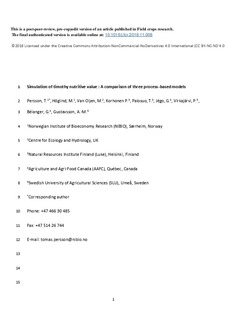| dc.contributor.author | Persson, Tomas | |
| dc.contributor.author | Höglind, Mats | |
| dc.contributor.author | van Oijen, Marcel | |
| dc.contributor.author | Korhonen, Panu | |
| dc.contributor.author | Palosuo, Taru | |
| dc.contributor.author | Jégo, Guillaume | |
| dc.contributor.author | Virkajärvi, Perttu | |
| dc.contributor.author | Bélanger, Gilles | |
| dc.contributor.author | Gustavsson, Anne-Maj | |
| dc.date.accessioned | 2019-04-08T10:43:51Z | |
| dc.date.available | 2019-04-08T10:43:51Z | |
| dc.date.created | 2019-01-11T12:57:57Z | |
| dc.date.issued | 2018-11-26 | |
| dc.identifier.citation | Field crops research (Print). 2018, 231 81-92. | nb_NO |
| dc.identifier.issn | 0378-4290 | |
| dc.identifier.uri | http://hdl.handle.net/11250/2593680 | |
| dc.description.abstract | Different forage grass models are used to simulate forage yield and nutritive attributes, but these models are seldom compared, particularly those for timothy (Phleum pratense L.), a widely grown forage grass species in agricultural regions with a cold temperate climate. We compared the models BASGRA, CATIMO and STICS for their predictions of timothy crude protein (CP) concentration, neutral detergent fibre (NDF) concentration and NDF digestibility (dNDF), three important forage nutritive attributes. Data on CP and NDF concentrations, and dNDF and the associated weather and soil data for seven cultivars, taken from eight field experiments in Canada, Finland, Norway, and Sweden, were divided into calibration and validation datasets. Model parameters were estimated for each cultivar separately (cultivar-specific calibration) and for all cultivars together (generic calibration), using different methods for the three models. Normalized root mean square error (RMSE) in prediction of CP concentration varied between 16 and 26% for BASGRA, 45 and 101% for CATIMO and 23 and 40% for STICS across the two calibration methods and the calibration and validation datasets. Normalised RMSE in prediction of NDF concentration varied between 8 and 13% for BASGRA, 14 and 21% for CATIMO and 8 and 12% for STICS, while for dNDF it varied between 7 and 22% for BASGRA, 7 and 38% for CATIMO and 5 and 6% for STICS. Cultivar-specific calibration improved the performance of CATIMO and STICS, but not BASGRA, compared with generic calibration. The prediction accuracy for NDF concentration and dNDF with the three models was within the same range or better than that for forage dry matter (DM) yield of timothy. Overall, the three models performed well in predicting some nutritive attributes and yield in Northern Europe and Canada, but improvements are required, particularly to increase the prediction accuracy of CP concentration. | nb_NO |
| dc.language.iso | eng | nb_NO |
| dc.rights | Navngivelse 4.0 Internasjonal | * |
| dc.rights.uri | http://creativecommons.org/licenses/by/4.0/deed.no | * |
| dc.subject | BASGRA | nb_NO |
| dc.subject | CATIMO | nb_NO |
| dc.subject | Crude protein | nb_NO |
| dc.subject | Fibre | nb_NO |
| dc.subject | Forage grass | nb_NO |
| dc.subject | Grassland | nb_NO |
| dc.subject | NDF | nb_NO |
| dc.subject | dNDF | nb_NO |
| dc.subject | STICS | nb_NO |
| dc.title | Simulation of timothy nutritive value: A comparison of three process-based models | nb_NO |
| dc.type | Journal article | nb_NO |
| dc.type | Peer reviewed | nb_NO |
| dc.description.version | acceptedVersion | nb_NO |
| dc.rights.holder | © 2018 Elsevier B.V. All rights reserved | nb_NO |
| dc.subject.nsi | VDP::Landbruks- og Fiskerifag: 900::Landbruksfag: 910::Planteforedling, hagebruk, plantevern, plantepatologi: 911 | nb_NO |
| dc.source.pagenumber | 81-92 | nb_NO |
| dc.source.volume | 231 | nb_NO |
| dc.source.journal | Field crops research (Print) | nb_NO |
| dc.identifier.doi | 10.1016/j.fcr.2018.11.008 | |
| dc.identifier.cristin | 1654896 | |
| dc.relation.project | Norges forskningsråd: 250643 | nb_NO |
| dc.relation.project | Andre: 277403 | nb_NO |
| dc.relation.project | Andre: 292836 | nb_NO |
| cristin.ispublished | true | |
| cristin.fulltext | postprint | |
| cristin.qualitycode | 1 | |

